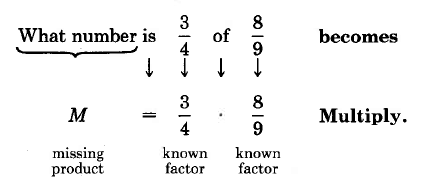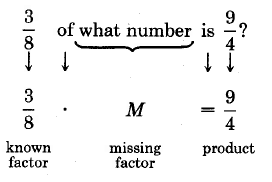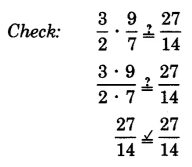4.6: Applications Involving Fractions
( \newcommand{\kernel}{\mathrm{null}\,}\)
- be able to solve missing product statements
- be able to solve missing factor statements
Multiplication Statements
Statement, Multiplication Statement
A statement is a sentence that is either true or false. A mathematical statement of the form
product = (factor 1) ⋅ (factor 2)
is a multiplication statement. Depending on the numbers that are used, it can be either true or false.
Omitting exactly one of the three numbers in the statement will produce exactly one of the following three problems. For convenience, we'll represent the omitted (or missing) number with the letter M (M for Missing).
- M = (factor 1) ⋅ (factor 2) Missing product statement.
- M ⋅ (factor 2) = product Missing factor statement.
- (factor 1) ⋅ M = product Missing factor statement.
We are interested in developing and working with methods to determine the missing number that makes the statement true. Fundamental to these methods is the ability to translate two words to mathematical symbols. The word
of translates to times
is translates to equals
Missing Products Statements
The equation M=8⋅4 is a missing product statement. We can find the value of M that makes this statement true by multiplyingthe known factors.
Missing product statements can be used to determine the answer to a question such as, "What number is fraction 1 of fraction 2?
Sample Set A
Find 34 of 89. We are being asked the question, "What number is 34 of 89?" We must translate from words to mathematical symbols.

M=1341⋅2893=1⋅21⋅3=23
Thus, 34 of 89 is 23.

M=341⋅6241=3⋅61⋅1=181=18
Thus, 18 is 34 of 24.
Practice Set A
Find 38 of 1615.
- Answer
-
25
Practice Set A
What number is 910 of 56?
- Answer
-
34
Practice Set A
1116 of 833 is what number?
- Answer
-
16
Missing Factor Statements
The equation 8⋅M=32 is a missing factor statement. We can find the value of M that makes this statement true by dividing (since we know that 32÷8=4.

Finding the Missing Factor
To find the missing factor in a missing factor statement, divide the product by the known factor.
missing factor = (product) ÷ (known factor)
Missing factor statements can be used to answer such questions as
38 of what number is 94?
What part of 127 is 11314?
Sample Set B

Now, using
missing factor = (product) ÷ (known factor)
We get
M=94÷38=94⋅83=3941⋅2831=3⋅21⋅1=6

Thus, 38 of 6 is 94.

For convenience, let's convert the mixed numbers to improper fractions.
M⋅97=2714
Now, using
missing factor = (product) ÷ (known factor)
we get
M=2714÷97=2714⋅79=327142⋅1791=3⋅12⋅1=32

Thus, 32 of 127 is 11314.
Practice Set B
35 of what number is 920?
- Answer
-
34
Practice Set B
334 of what number is 229?
- Answer
-
1627
Practice Set B
What part of 35 is 910?
- Answer
-
112
Practice Set B
What part of 114 is 178?
- Answer
-
112
Exercises
Exercise 4.6.1
Find 23 of 34.
- Answer
-
12
Exercise 4.6.2
Find 58 of 110.
Exercise 4.6.3
Find 1213 of 1336.
- Answer
-
13
Exercise 4.6.4
Find 14 of 47.
Exercise 4.6.5
310 of 154 is what number?
- Answer
-
98 or 118
Exercise 4.6.6
1415 of 2021 is what number?
Exercise 4.6.7
344 of 1112 is what number?
- Answer
-
116
Exercise 4.6.8
13 of 2 is what number?
Exercise 4.6.9
14 of 3 is what number?
- Answer
-
34
Exercise 4.6.10
110 of 1100 is what number?
Exercise 4.6.11
1100 of 110 is what number?
- Answer
-
11,000
Exercise 4.6.12
159 of 247 is what number?
Exercise 4.6.13
1718 of 415 is what number?
- Answer
-
1027
Exercise 4.6.14
118 of 11116 is what number?
Exercise 4.6.15
Find 23 of 16 of 92.
- Answer
-
12
Exercise 4.6.16
Find 58 of 920 of 49.
Exercise 4.6.17
512 of what number is 56?
- Answer
-
2
Exercise 4.6.18
314 of what number is 67?
Exercise 4.6.19
103 of what number is 59?
- Answer
-
16
Exercise 4.6.20
157 of what number is 2021?
Exercise 4.6.21
83 of what number is 179?
- Answer
-
23
Exercise 4.6.22
13 of what number is 13?
Exercise 4.6.23
16 of what number is 16?
- Answer
-
1
Exercise 4.6.24
34 of what number is 34?
Exercise 4.6.25
811 of what number is 811?
- Answer
-
1
Exercise 4.6.26
38 of what number is 0?
Exercise 4.6.27
23 of what number is 1?
- Answer
-
32 or 112
Exercise 4.6.28
315 of what number is 1?
Exercise 4.6.29
1912 of what number is 514?
- Answer
-
3
Exercise 4.6.30
3125 of what number is 2815?
Exercise 4.6.31
What part of 23 is 119?
- Answer
-
53 or 123
Exercise 4.6.32
What part of 910 is 335?
Exercise 4.6.33
What part of 89 is 35?
- Answer
-
2740
Exercise 4.6.34
What part of 1415 is 730?
Exercise 4.6.35
What part of 3 is 15?
- Answer
-
115
Exercise 4.6.36
What part of 8 is 23?
Exercise 4.6.37
What part of 24 is 9?
- Answer
-
38
Exercise 4.6.38
What part of 42 is 26?
Exercise 4.6.39
Find 1213 of 3940.
- Answer
-
910
Exercise 4.6.40
1415 of 1221 is what number?
Exercise 4.6.41
815 of what number is 225?
- Answer
-
92=412
Exercise 4.6.42
1115 of what number is 2235?
Exercise 4.6.43
1116 of what number is 1?
- Answer
-
1611 or 1511
Exercise 4.6.44
What part of 2340 is 3920?
Exercise 4.6.45
435 of 3922 is what number?
- Answer
-
3077
Exercises for Review
Exercise 4.6.46
Use the numbers 2 and 7 to illustrate the commutative property of addition.
Exercise 4.6.47
Is 4 divisible by 0?
- Answer
-
no
Exercise 4.6.48
Expand 37. Do not find the actual value.
Exercise 4.6.49
Convert 3512 to an improper fraction.
- Answer
-
4112
Exercise 4.6.50
Find the value of 38 \div \dfrac{9}{16} \cdot \dfrac{6}{5}\).


